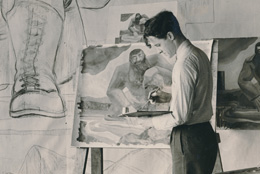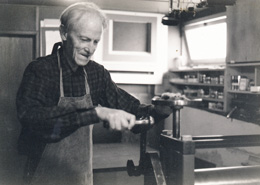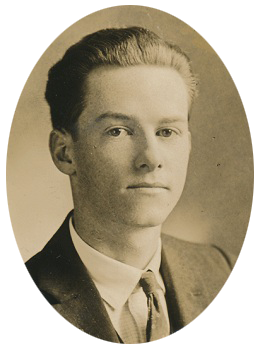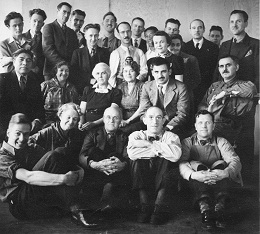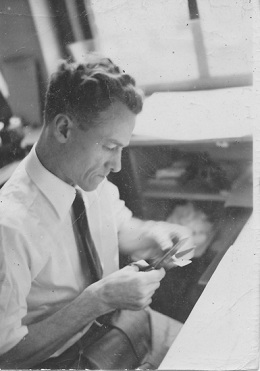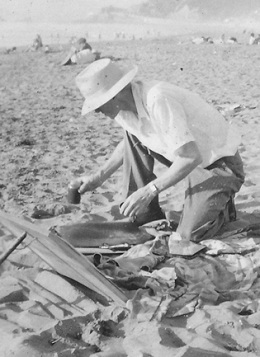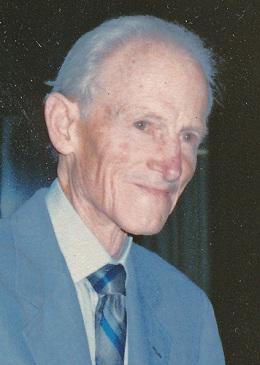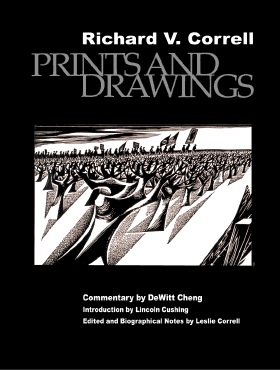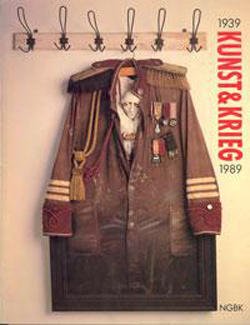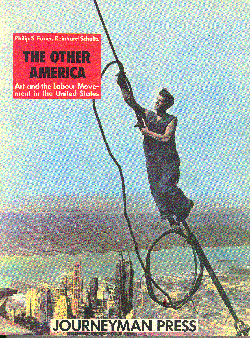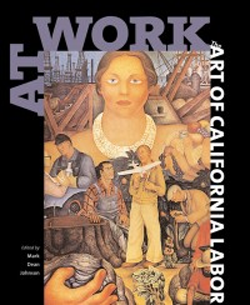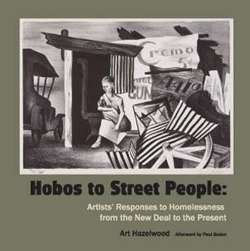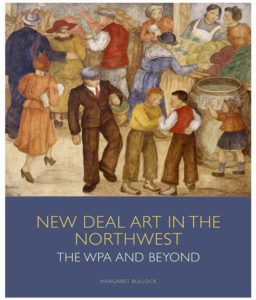About Richard V. Correll and His Work
Artist Richard V. (Dick) Correll (1904-1990), described as “one of the leading masters of printmaking in the West”*, was best known for his powerful black and white linoleum cuts, etchings and woodblock prints. For most of his life he earned a living as a commercial artist in the book publishing and advertising fields while producing a large body of fine art in his own time. His themes ranged from landscapes, animals and agricultural scenes, harbors and ships, and music and dance to those which reflected his lifelong concern with political and social issues. As one curator wrote, “the maturity of his technique, with its rich textures and dramatic contrasts, combines with a wide range of subject matter to produce a body of work of great warmth, power, and depth”. Correll stated that, above all, he was a humanist.
Correll's work is preserved in the book, Richard V. Correll - Prints and Drawings. With more than 100 images spanning six decades of printmaking, this is the first comprehensive look at the art of Richard Correll. Click here for more information.
Early life
Born in 1904, Richard V. (Dick) Correll spent most of his life in the three Western states, spending his early years in small farms or towns in Oregon and California. He absorbed his intellectual thirst – and the craft of fine woodworking - from his father, a lawyer, school teacher master carpenter and voracious reader, and the love of art and music from his mother, a musician trained at Oberlin. A natural artist from early childhood, by the age of four Dick was cutting perfect farm animals out of paper with his mother’s sewing scissors. He was largely self-taught: “I combed the library of every place we moved to for reproductions and critical articles on artwork or artists. I’m a constant student.” He also became sensitized to the environment early on through working in his family’s small garden plots and farms and caring for the occasional family cow, horse or flock of chickens.
By the later 1920s the family had moved to Los Angeles. Dick's father and uncle began building houses there during the housing boom, with Dick doing the architectural drafting and his younger brother the electrical work. The two young men helped their father and brother with everything from basic construction to fine cabinetry. After the building boom collapsed with the Depression, Dick opened a couple of sign shops and did sign painting and calligraphy. He took a few art classes at what was then Chouinard Art Institute, but never attended as a matriculated student. He continued to sketch and draw on his own.
Dick's political thinking deepened with the Depression and seeing flocks of people uprooted by the Dust Bowl, hungry and homeless, stream into California. He began to see that art could be a vehicle to express ideas.
Seattle and the W.P.A.
In 1934 Correll moved to the Seattle, Washington area, and by the late 30’s was selected to participate in the Federal Art Project of the Works Project Administration (WPA), part of the New Deal. This recognition confirmed his decision to pursue art professionally, and gave him (and many other artists as well) an opportunity to earn their livings as fine artists, practicing artists for the first, and sometimes the only time in their lives. While working alongside such artists as Morris Graves, Mark Tobey, Faye Chong, Julius Twohy and Hannes Bok, Correll’s work matured and his style crystallized.
Correll specialized in printmaking, primarily wood and linoleum block prints, but produced etchings and lithographs as well. In addition, he produced drawings, gouache paintings and two murals. Especially notable from Correll’s WPA period is a suite of prints depicting the legendary American folk hero, Paul Bunyan. In one exhibition catalogue these were described to be “as large in spirit as their inspiration.” Reportedly he produced work in more different media than any of the other Seattle artists.
During the Seattle years, Correll was a founding member of the Washington Artists’ Union. He married his wife Alice in 1938. He had several solo shows and exhibited widely in national juried group shows (Print Club of Philadelphia, the California Etcher’s Society, and the San Francisco Museum of Modern Art’s Print Annual.) In 1939 his work was exhibited at the New York World’s Fair. Many of the works from the WPA period are today in the collections of museums, universities, and public buildings and continue to be shown and circulated. His murals of Paul Bunyan remain in a high school in Bremerton, Washington.
New York City 1941 – 1952
Curator and fine print dealer M. Lee Stone wrote, “In 1941 Correll and his wife moved to New York City where he remained for 11 years working in the commercial art field. New York's commercial and fine art scenes, however, were not without their difficulties. While commercial work paid decently, Correll always thought it a 'sorry thing' to use one's artistic abilities to sell products. His values were completely opposed to those of Madison Avenue, and this contradiction plagued him throughout his commercial career.
As America entered World War II, Correll, at 36, was too old for the draft. He joined the Civilian Defense Corps as an Air Raid Warden in the Greenwich Village area. He also did artwork for Civil Defense, producing dozens of pro bono flyers, banners, signs and posters for various causes.” Daughter Leslie was born in 1944.
After joining the Artists League of America (ALA), an organization of progressive artists and sculptors "devoted to social, cultural, and economic interest of artists", Correll served as Publication Chair of the ALA News from 1943 on, and by 1946 was Editor. Membership in those years included Rockwell Kent, Lynd Ward, Jacob Lawrence and Moses Soyer. He exhibited regularly with ALA, and his linocut, "Air Raid Wardens" was included in the "Artists for Victory" travelling exhibition at the Metropolitan Museum of Art and 26 other venues in the USA and Canada.
Correll remarked, “New York was an especially exciting place for an artist during these years. Murals by the Mexican artists could be seen in the School for Social Research as well as in the Museum of Modern Art. Refugees from fascist persecution were bringing over the latest European art theories.” George Grosz was teaching at the Art Students League. Correll knew Fritz Eichenberg, Robert Gwathmey and Miguel Covarrubias among others. Receiving serious attention in New York for the first time were works by Kathe Kollwitz, Edvard Munch, Miguel Covarrubias, Joseph Cornell, and the major collection of African sculpture owned by fellow ALA member Ladislas Segy. Fellow artists Norman Barr, Harry Roth and Abe Blashko were good friends of the Corrells.
San Francisco Bay Area
In 1952 Dick had had enough of Madison Avenue and the family moved back to the West Coast, this time to San Francisco. Soon Dick joined the newly-formed Graphic Arts Workshop and Printmaker’s Gallery of San Francisco, a dynamic group of progressive artist-activists who shared studio and exhibition space as well as the desire to serve the ideals of peace and social justice through their artwork. The GAW was then located in North Beach, which threw Dick into the vital art and cultural movement of the 50’s. Through his lifelong membership in the Workshop he met and worked with many other noted San Francisco artists and muralists of his generation such as Victor Arnautoff, Pele de Lappe, Irving Fromer, Louise Gilbert, Stanley Koppel, Emmy Lou Packard, Frank Rowe and William Wolff. In 1954 he realized a lifelong dream of visiting México, the famous Taller de Gráfica Popular and the great works of Rivera, Orozco and Siqueiros that had so influenced him and his generation.
Correll showed and won prizes at the annual San Francisco Art Festivals and around the Bay Area and California. In 1969 Correll happily retired from the commercial art field and was able to work full time at his fine art. The family moved to Oakland, across the Bay from San Francisco in 1972, where Dick could at last have a garden and a large studio. Upon the occasion of his 80th birthday he was honored with a major retrospective exhibition and community celebration. He died in 1990 at the age of 85. A monograph on his work (Richard V. Correll: Prints and Drawings) was published in 2005, to recognize the centenary of his birth.
Style and Influence
Since the 1930s Dick had noted the trend in mainstream art toward eliminating the human element, and Abstract Expression and observed how it swallowed the New York art scene while living there from 1941 - 52. Again Dick Correll ignored the trends and pressures, and went his own way. “I admired a lot of those artists from the standpoint of design, color, visual effects in contrast with, say, Victorian artists." He saw the “modernists” veering away from the traditional humanism of Western art toward abstraction, but he strove to synthesize that abstract strength (of composition and design) with his own humanistic, representational subject matter. “What interested me more than anything else was the technique, how to do things, rather than art theory, because I always felt that I had my own ideas of what I wanted to do.”
On two occasions he participated with other artists in an attempt to form a union: in Washington with the Washington Artists Union and in New York City with the Artists League of America. Colleagues in the latter included Rockwell Kent, Lynd Ward, Philip Evergood, Ladislas Segy, Harry Gottlieb, Robert Gwathmey, Moses Sawyer, Art Young and Harry Sternberg. Correll served as the organization's Publications Chair and Editor of the A.L.A. News.
Correll’s innate distaste for self-promotion and introspective temperament also limited his exposure as a fine artist. Although he had confidence in the quality of his work, he recognized that his work would never be seen as “mainstream.” Neither did he have the personality to actively pursue exhibition possibilities outside of the mainstream venues, preferring to respond to opportunities that came his way. This is probably the chief reason that his art is little known today.
Correll’s gentle and reserved demeanor was in sharp contrast to what San Francisco art critic Thomas Albright saw as the “remarkable boldness and strength” of his artwork. His themes often reflected his social conscience and he was attracted by heroic acts committed by everyday people in the struggle to achieve respect, freedom, and human rights. He marched with César Chávez and the United Farm Workers on their historic journey from Delano to Sacramento, contributed to and mounted the inaugural exhibition for the S.F. Afro-American Historical and Cultural Society, and created countless posters, leaflets, signs, and exhibits to civil rights, Native American, senior, labor, environmental, and world peace groups.
Although never formally a teacher, Correll’s masterful command of technique and powerful composition blended with compassionate, humanistic subject matter influenced and inspired many of the younger generation of West Coast printmakers and graphic artists. He sought to express the innate dignity of every person and the interdependence of people with each other and with nature. Some of his prints celebrate the reassuring pleasures and experiences of daily life, while others assail the most disturbing realities of the twentieth century – war, injustice and persecution. But by the act of making art Correll expressed both his belief in the power of art to help change those realities and his faith in the future.
A permanent archive of Correll's work has been established at the University of Washington - Labor Archives of Washington State / Libraries Special Collections, Seattle, Washington.
*Thomas Albright, Art Critic, San Francisco Chronicle

